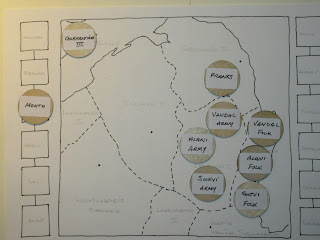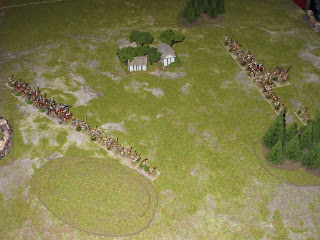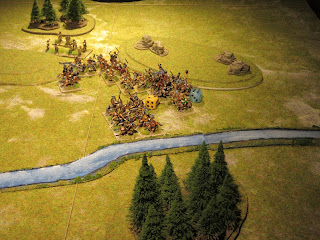Synopsis
In 407, Constantine III had
signed a treaty with the invaders and moved south to confront Stilicho. Gothic
forces lead by Sarus, a general of Stilicho, had some successes but are
eventually defeated by Constantine’s magister militum, Gerontius. In the spring
of 408, Stilicho gathers new forces to resume his fight against Constantine
III. Constantine III, after gaining control of Arelate (Arles) makes his son
Constans Caesar and sends him to Hispania to capture the relatives of Honorius.
They are later executed to further securing his position as “emperor” in the
west.
Barbarian Player
The treaties signed by the
barbarian leaders would recognize a status quo and pledges of no further
movement. Naturally, treaties between the barbarians and Rome have seldom demonstrated
longevity, so the barbarian player will need to mark time and accumulate as
many points as he can. However, this will
cause discord among a number of tribal leaders not only within the Vandal camp,
but among the Alan and Suevi.
There are two directions to
reflect this and one, is to increase the points required to move barbarian
counters and two, prohibit the replacement of troops from within ones on tribe.
The latter option reflects those tribes that remained in the province to settle
or tribes that joined other nations to trek further west.
Both options will be tested.
Roman Player
The primary threat to
Constantine III’s position is not the barbarian threat, but Stilicho’s new
offensive. Constantine III moves south to take control of Arelate (Arles) which
would place him in a better position to threaten western Italia. Gallia has
become supportive for their new emperor.
The Franks will return to
their province of Germania II if it is no longer threatened by the barbarian
presence. Despite the treaties made with the barbarians, the provinces of
Gallia are hesitant to release their troops to join the main army of
Constantine III’s army. Therefore any losses of Roman troops cannot be replaced
until August 408.
Game map two.
In map two, as we move further
west we note the appearance of new provinces. These should be the provinces of
Lugdenensis Senonia, Lugdenensis I, II and III, Aquitania I and II.
































